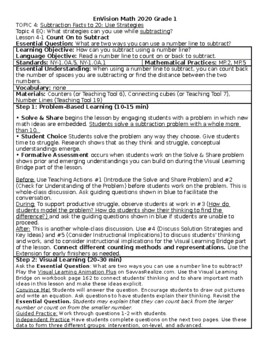Grade 1 enVision Math 2020 Topic 4 Lesson Plans EDITABLE
Eva Szymanski
30 Followers
Grade Levels
1st
Subjects
Resource Type
Standards
CCSS1.OA.B.4
CCSS1.OA.C.5
CCSS1.OA.C.6
Formats Included
- Word Document File
Pages
18 pages
Eva Szymanski
30 Followers
Also included in
- All 15 Topic are included. Please make sure you have the newest enVision Math 2020 version! It is not for the previous, enVision Math 2.0 version. TOPIC 1 Understand Addition and SubtractionTOPIC 2 Fluently Add and Subtract Within 10TOPIC 3 Addition Facts to 20: Use StrategiesTOPIC 4 Subtraction FacPrice $104.80Original Price $131.00Save $26.20
Description
Detailed and fully editable lesson plans for the newest enVision Mathematics edition 2020, Grade 1, Topic 4 Subtraction Facts to 20: Use Strategies.
Lessons included:
Lesson 4-1 - Count to Subtract
Lesson 4-2 - Make 10 to Subtract
Lesson 4-3 - Continue to Make 10 to Subtract
Lesson 4-4 - Fact Families
Lesson 4-5 - Use Addition to Subtract
Lesson 4-6 - Continue to Use Addition to Subtract
Lesson 4-7 - Explain Subtraction Strategies
Lesson 4-8 - Solve Word Problems with Facts to 20
Lesson 4-9 - Problem Solving: Reasoning
Correlated to New York State Next Generation Mathematics Learning Standards.
All Topics are now available as a bundle!
Total Pages
18 pages
Answer Key
N/A
Teaching Duration
N/A
Last updated Oct 16th, 2021
Report this resource to TPT
Reported resources will be reviewed by our team. Report this resource to let us know if this resource violates TPT’s content guidelines.
Standards
to see state-specific standards (only available in the US).
CCSS1.OA.B.4
Understand subtraction as an unknown-addend problem. For example, subtract 10 – 8 by finding the number that makes 10 when added to 8.
CCSS1.OA.C.5
Relate counting to addition and subtraction (e.g., by counting on 2 to add 2).
CCSS1.OA.C.6
Add and subtract within 20, demonstrating fluency for addition and subtraction within 10. Use strategies such as counting on; making ten (e.g., 8 + 6 = 8 + 2 + 4 = 10 + 4 = 14); decomposing a number leading to a ten (e.g., 13 - 4 = 13 - 3 - 1 = 10 - 1 = 9); using the relationship between addition and subtraction (e.g., knowing that 8 + 4 = 12, one knows 12 - 8 = 4); and creating equivalent but easier or known sums (e.g., adding 6 + 7 by creating the known equivalent 6 + 6 + 1 = 12 + 1 = 13).






